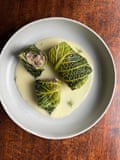
Plump parcels of rice-stuffed vine leaves might be more familiar to Greece’s millions of summer visitors than these hearty braised cabbage rolls, but, as Athens native Carolina Doriti explains in her book Salt of the Earth, dolmades come in many different guises. In many areas of the country, these lahanodolmades are traditionally served on Orthodox Christmas Day, the cabbage standing in for the swaddling bands of the infant Christ, and they’re especially popular “on the islands, in northern Greece and the Epirus region”.
That said, they’re not just for Christmas: Rena Salaman recalls neighbours coming round on dark mornings to help her mother and grandmother prepare what she calls “all in all, a winter dish … ideal for England with the abundance of the (notorious) English green cabbage, which at last can serve a more worthwhile purpose than usual!” Though I object to the shade thrown on our brassica cookery, I can’t disagree that this is a wonderful winter dish, whether or not you’re celebrating Orthodox Christmas this weekend.
The cabbage
No swaddling required here – Salaman notes that “even though in Greece the white Dutch cabbage is used, the same variety here seems to be much harder and woody, and it does not make a good candidate for stuffing”. She recommends using that “notorious” green version, which is harder to find than it used to be, though, aesthetically, I’m drawn instead to the ridged savoy that London’s Mazi restaurant uses “to give the dish a splash of vivacious colour”. That said, use whatever you enjoy and can find, with the caveat that the larger the leaves, the better, as long as they’re in good condition; Aglaia Kremezi suggests a combination of savoy and collard greens, for which I substitute spring greens. The shape is the all-important thing here, and much as my testers and I enjoy the richer, more overtly bitter flavour, all but the biggest leaves prove a pain to roll, so proceed with caution.
The same goes for how you prepare them. If you’re scaling up the recipe to make a big pot, the easiest way to do so is to cut out the woody core and cook the cabbage whole, as Doriti and Akis Petretzikis do, but because the smaller inner leaves are less useful, and won’t last so long once cooked, for smaller amounts, I’d advise blanching just what you need, as Mazi does, and keeping the rest for another purpose.
Doriti tells her readers that many cooks make this with the pickled cabbage leaves that are traditionally prepared on St Catherine’s Day, 25 November, for the express purpose. No vinegar is involved; instead, they’re fermented in water, lemons and barley or chickpeas – “many drink the pickled cabbage liquid as a hangover cure or as a remedy for an upset stomach”. This, of course, takes time, so instead she adds slices of lemon to the pan, to “recreate the lemony flavor of this style of pickled cabbage leaves”. The resulting tanginess works very well with the richness of the pork.
You’ll inevitably end up with some offcuts from the cabbage – pieces of tough stem and holey outer leaves – so use these to line the pan, which will have the added benefit of preventing the rolls sticking. Doriti admits that she loves to eat these bits, too, and also adds the stems from the herbs to help flavour the broth.
The meat

Doriti says that, traditionally, the rolls were filled with minced or chopped pork, rice and herbs, but that these days recipes, including her own, often include minced beef. Even so, “the addition of pork one way or another is key, as it goes really well with the flavor of the cabbage”. Mazi also uses a combination of meats, Rosemary Barron goes for pork or beef in her book Flavours of Greece, Salaman for lamb, veal, beef or pork, and Petretzikis for beef alone.
I’m inclined to agree that pork is a better pairing for cabbage – its fattiness makes for a more satisfying richness, while subtler, leaner meat tends to get a bit lost – but by all means substitute another meat if you don’t eat it. The same goes for the pancetta that Kremezi uses in her filling and that Doriti tucks into the pan to season the cabbage offcuts; it encourages emptying the entire pan, but it’s not mandatory.
Barron and Kremezi both fry their meat first, which has the benefit of releasing its fat, but makes the finished rolls less juicy, so I’d prefer to use it raw.
The rice
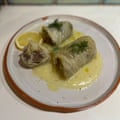
Dolmades are often filled with rice and herbs rather than meat. Though lahanodolmades, or lachanodolmades, are commonly made with pork, too much or not enough rice will make them dry and dense. Most recipes call for the carolina variety, a starchy round grain that can be found in specialist Greek food stores, but plump, starchy risotto rice such as arborio makes a fine replacement.
Salaman and Barron both buck the trend and use long-grain, which will work if that’s all you have, but its tendency to fluffiness gives the rolls a different, looser and, to me, less satisfying texture.
The seasoning

Everyone uses finely chopped onion, and Doriti and Mazi add spring onion, too – its hotter, greener flavour brings freshness to their fillings. They also add their onion, both brown and white respectively, raw, but most recipes saute it first, and I like the sweetness this imparts. Interestingly, Salaman is firm that “the stuffing is always used raw”, but permits this sauteing of the onion. Petretzikis adds garlic as well, but we can’t taste it in the finished dish, so I don’t think it adds much.
He’s also the only person to use rosemary; dill and mint, both fresh and dried, are far more popular. Dill always tastes to me of Greece, as does Doriti’s dried mint, which is one of the few herbs to earn its place dried in a jar – what it lacks in sweet freshness it makes up for in pungency. If you have an aversion to either of those, though, feel free to replace them with parsley and/or fresh mint.
Petretzikis, who seems to be something of a maverick, seasons his filling with cumin, Barron uses allspice and Kremezi aleppo pepper, while Doriti sprinkles her wrapped rolls with smoked paprika, which is, she says, a northern Greek touch. I’m going to use the unsmoked variety, because I think its fruity acidity works better with the other flavours, but it’s entirely up to you.

Doriti peppers her filling with grated carrot, which looks attractive, but if little pops of sweetness are what you’re after, then, for sheer festivity, I prefer the currants in Barron’s dish, which she teams with toasted pine nuts for crunch and a squeeze of lemon juice or a drop of vinegar for balance, which works well. As I’m adding lemon to the pan to flavour the cabbage, however, using both feels like overkill.
Alternatively, for a more richly savoury filling, you might like to consider Kremezi’s recipe from Corfu, which involves ripe tomatoes, red wine and grated cheese. Delicious, but so full-flavoured that no sauce is required.
The sauce

The recipes I try are divided between those that make a sharply lemony avgolemono sauce (either thickened with egg, as in Kremezi’s version, or starch) and those, such as Barron, who opt for a rich tomato sauce. Kremezi has a foot in both camps, adding tomato juice to her avgolemono, which turns it a lovely pink colour.
For me, though, both approaches risk overwhelming the rolls. Instead, I like Doriti’s method of cooking the dolmades in stock (homemade pork stock in her case, which is a very good idea if you have the time – though fresh chicken stock makes a very acceptable substitute). The stock can then be turned into a tangy, citrussy sauce. After all, it’s a shame to waste all that flavour (though if you would like the more intensely lemony sort, I’d suggest adopting Kremezi’s idea of using the cooking liquid to make it). You can stir in some tomato puree, as Doriti does, if you’d like to give it a little extra oomph.
The cooking
Though the exact cooking time will depend on how many you’re doing, Petretzikis’s hour and a half feels like overkill, not least because the scent of boiled cabbage brings back unhappy memories. Mazi’s 30-40 minutes feels ample, but be sure to carefully open one roll to check it’s cooked before taking them all off the heat.
Kremezi recommends cooking the rolls in advance and leaving them to sit overnight, so the flavours develop. While certainly not essential, this is certainly very useful if you’re the kind of cook who likes to get ahead.
Perfect lahanodolmades
Prep 10 min
Cook 1 hr
Serves 4
Salt and black pepper
1 large savoy or round green cabbage
25g pine nuts (optional)
2 tbsp olive oil, plus extra to serve
1 small onion, peeled and finely chopped
2 spring onions, trimmed, and white and green parts chopped
250g pork mince
100g short-grain rice
1 tsp dried mint, or 1 tbsp chopped fresh mint
3 tbsp dill, or parsley, leaves picked and finely chopped, stems reserved
25g currants (optional)
100g sliced pancetta, or thick-cut unsmoked bacon, finely chopped (optional)
Paprika (optional)
1 lemon, sliced into thin rounds
1 litre fresh chicken or pork stock
Bring a large pan of salted water to a boil and fill the sink or a large bowl with cold water. Peel off about 12 large cabbage leaves, keeping any torn outer ones to line the pan with later.
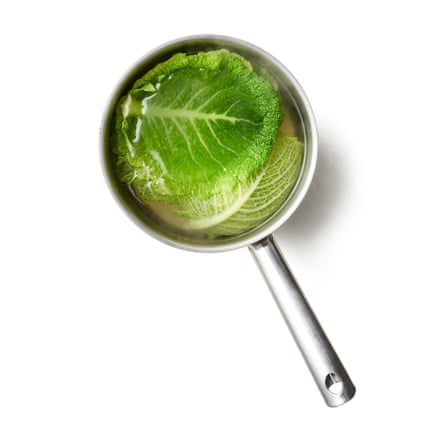
Blanch the leaves, in batches if necessary, in the boiling water for three to five minutes (the timing will depend on their size), until floppy but still green, then drain, plunge into the cold water, drain again and dry on a clean tea towel.

Put a dry frying pan on a medium heat, then toast the pine nuts until lightly golden.
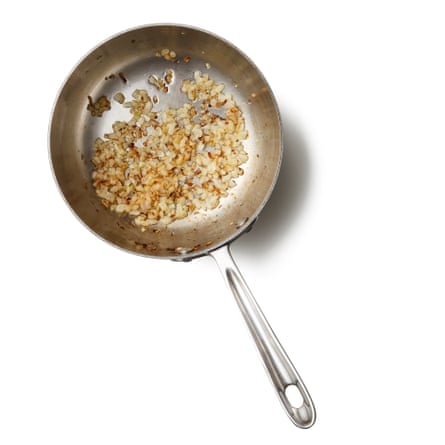
Tip out on to a plate, add the oil to the hot pan, then saute the finely chopped brown onion until soft and glossy.
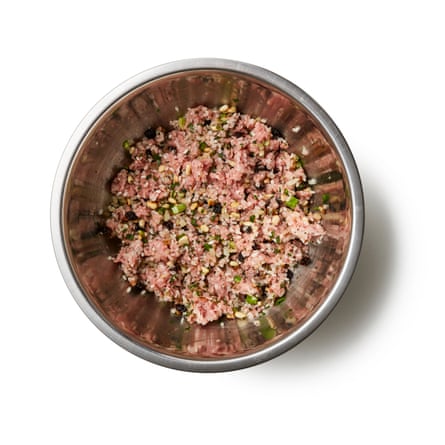
In a bowl, mix the fried onion with the spring onions, pork, rice, mint, dill, currants and pine nuts, and season generously.
Line a saucepan with the reserved torn cabbage leaves and the dill stems. You need something that’s big enough to hold all the rolls, but tightly packed, so it needs to be wide enough to do so or deep enough to accommodate them in a couple of layers.
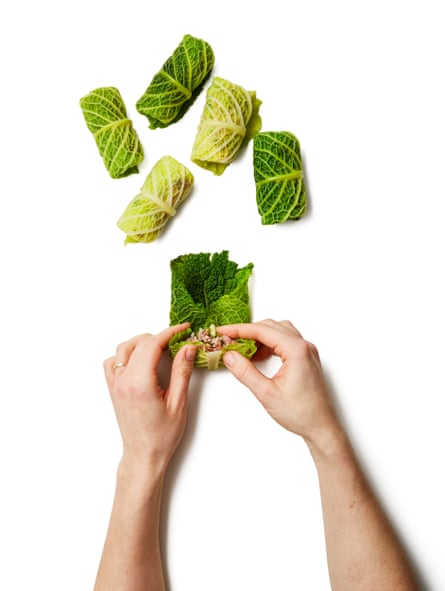
Place one blanched cabbage leaf flat on a board with the stem end facing you. Trim the base to make a straightish line, if need be. If the stem is still too tough to roll at the bottom, cut that part out and put it in the cabbage-lined pan. Put a spoonful of the filling in a line just shy of the bottom of the leaf, then fold in both sides of the leaf over the top. Bring the bottom of the leaf up and over the top of the filling, then keep rolling it into a tight sausage.
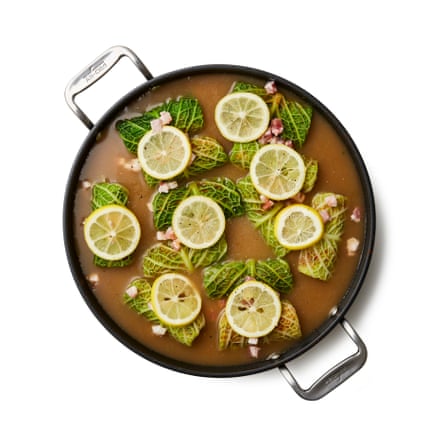
Place seam-side down in the pan, then repeat with the remaining blanched leaves and filling, packing them in tightly, and in layers, if necessary. Scatter over the pancetta, if using, and paprika as you go, and top each layer of rolls with lemon slices.
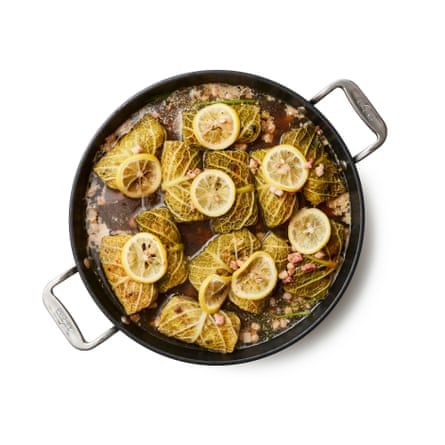
Pour in the stock just to cover the rolls, then put something heatproof on top to weigh them down (I used a smaller pan lid), and cover. Bring to a simmer, then turn down the heat and leave to cook for 30-40 minutes.
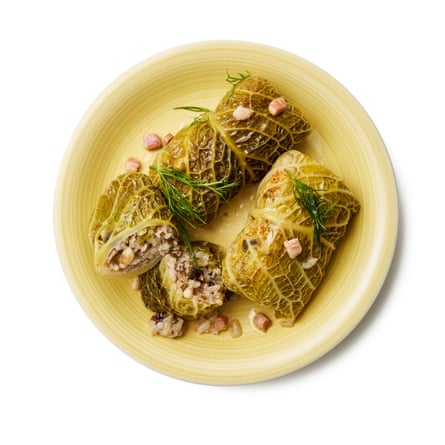
Carefully lift out the rolls, pancetta, lemon and leaves, discarding the herb stems, and keep warm. Taste the cooking liquid, season and reduce to taste as necessary. Serve ladled over the top of the rolls, with the pancetta, lemon slices, a drizzle of olive oil and a little more fresh dill.
-
Dolmades – which is your favourite sort, and which of the world’s many wonderful stuffed cabbage recipes are also close to your heart? And what will you be eating if you’re celebrating Orthodox Christmas this weekend?



